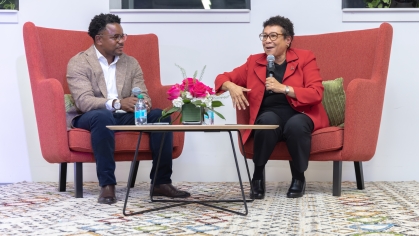CMBN Professor Awarded $1.5 Million Grant to Study Promising Brain Therapy
Non-invasive Transcranial Current Stimulation therapy is catching on, but more study is needed.
Professor Bart Krekelberg, a neuroscientist at Rutgers University–Newark’s Center for Molecular and Behavioral Neuroscience (CMBN), has been awarded a $1.5 million grant from the National Institutes of Health’s BRAIN Initiative.
Krekelberg, who serves as Associate Director of CMBN and the Rutgers University Brain Imaging Center (RUBIC), received the four-year grant to study Transcranial Current Stimulation (TCS), a promising, noninvasive technique that uses electrodes placed on the scalp to send weak electrical currents into the brain, creating small electric fields that modulate, or excite, neuron activity.
TCS has strong clinical potential for treating depression and other conditions, reducing epileptic seizures, and even increasing cognitive performance in healthy volunteers. It also is portable (battery-operated), inexpensive, and easily deployable in clinics and at home. Not surprisingly, more clinicians are trying this modality, the number of TCS studies has increased, and there's been no shortage of media attention, as well as companies selling battery-electrode kits for home use.
Despite this, there is substantial uncertainly about how it works to change or enhance brain functioning, and even its basic dosage/response relationships are poorly understood.
That’s where Krekelberg and his lab team come in.
Their goal is to better understand what happens to brain neurons during TCS and to study the effects on neural activity using direct, alternating and random-noise currents.
That means recording brain activity to determine how current strength, duration and pattern affect neural information processing.
"We'll develop and validate new techniques and develop software—in other words, fine-tune the equipment that we'll use for further study," says Krekelberg. "And as we test these variables, we'll start to come away with a better understanding of TCS' impact on the brain."
He acknowledges that recording brain activity while stimulating it electrically poses challenges: Namely, his team has to distinguish between the stimulant and its effects. To do this, they'll stimulate neurons using each kind of current, turn off the electrical currents for mere milliseconds, then measure. To observe the brain during these minuscule gaps requires special amplifiers and other equipment, which will be part and parcel of the testing phase.
Also posing a challenge will be managing the complexities of the three currents (direct, alternating and random-noise), given the sheer number of possibilities they present. DC is the easiest, Krekelberg says, followed by AC, which involves many more variables. Then there's random-noise, where no predictable pattern of current exists.
"Some things are actually easier with random-noise current, but there are fewer models out there, and so less is known about it," says Krekelberg. "People have shown that it can work, and so we'll look at the underlying mechanisms to see how."
Krekelberg hopes this NIH-funded research leads to a much more refined application of TCS in clinical settings, while further unlocking the mysteries of the brain. He credits his team for helping to move the project forward. They include two post-docs (Kohitij Kar and Jacob Duijnhouwer) and one Ph.D. student (Yinghua Liu).
In fact, Krekelberg's grant proposal grew out of research done in his lab from 2012 to 2016 by Kar, who has moved on to MIT but continues to consult on the project, which is part of NIH's BRAIN Initiative.
Launched by President Obama in 2013, the BRAIN Initiative is a groundbreaking multimillion-dollar, multi-agency approach that leverages new technologies and collaborations to revolutionize our understanding of the human brain.
Its goal: to help neuroscientists develop a more complete arsenal of tools and information for understanding how the brain functions both in health and disease, and to pioneer effective ways of helping people suffering from conditions such as Alzheimer’s, Parkinson’s, autism, epilepsy, schizophrenia, depression and traumatic brain injury.
Krekelberg is grateful for the funding and happy to be part of such important work.
"The exciting thing about TCS for me is that it's possible to change the brain without opening it up," he says. "And it's relatively inexpensive and safe. So the potential is huge."


